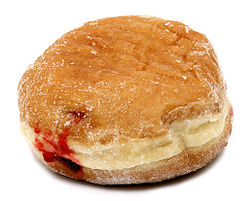Jelly doughnut
 | |
| Type | Doughnut |
|---|---|
| Variations | Berliner, jam doughnuts, sufganiyot, bomboloni, krafne, pączki |
A jelly, or jam doughnut is a doughnut filled with jam filling. Varieties include the German Berliner, Australia, Britain and Nigeria's jam doughnuts, sufganiyot from Israel, and the jelly-filled doughnuts sold in the United States and Canada. Japanese anpan are similar to the Berliner, except they contain red bean paste. Krafne from Southern Europe also include a jelly-filled variety. In Italy, bomboloni are popular. Bavaria and Austria also have a jelly doughnut known as Krapfen that is typically filled with apricot jam and topped with powdered sugar.
History
The first record of a jelly doughnut appeared in the Polish translation (Kuchmistrzostwo) of a German cookbook published in 1532. It is uncertain whether or not that was the precise date of the jelly doughnut's invention. Known then as Gefüllte Krapfen, it spread throughout Europe over the next century, sometimes with other fillings considering sugar and jelly was sparsely found at the time, but Caribbean sugar plantations made both more widely available. [1]
By region
Australia
Hot jam doughnuts are popular all over Victoria. They can be found at fairs and markets, and they are commonly sold out of food trucks. They are similar to traditional German and American jelly doughnuts, but with more yeast in the dough and always served very hot.[2] They are served so warm that it is common for consumers to burn their tongue on the jam.[3]
United States
A 1942 headline in the Hartford Courant Of Connecticut reported that "Jelly Doughnut Diets Harmful to War Effort."[4] A 1976 Los Angeles Times story explains how to make jelly doughnuts from scratch for a "tasty after-school" snack for youngsters.[5]
In a 1997 taste test, Ruth Reichl graded jelly doughnuts from a local doughnut shop higher than ones from national chain doughnut shops.[6]
Israel
Jelly or custard filled doughnuts are known as sufganiyot in Hebrew and are a popular Hanukkah treat. They are cooked in oil which is in keeping with the theme of the holiday, celebrating one day's worth of oil "keeping a sacred lamp alight for eight."[7][8]
Gallery
-
A jelly doughnut sliced into two, showing the jelly filling
-
A raspberry donut from the Peter Pan bakery
See also
References
- ^ Marks, Gil (2010). Encyclopedia of Jewish Food. Boston: Houghton Mifflin Harcourt. ISBN 978-0470391303.
- ^ Kerr, Jack (16 September 2015). "The Secret History of the Hot-Jam Doughnut". Broadsheet. Retrieved 10 July 2020.
- ^ Cowie, Tom (February 10, 2018). "Some like it hot: Melbourne's long love affair with the jam doughnut". The Age. Retrieved 10 July 2020.
- ^ "Jelly Doughnut Diets Harmful to War Effort", May 26, 1942, page 10, The Hartford Courant (Hartford, Connecticut)
- ^ "Jelly Doughnuts From Scratch", Los Angeles Times December 9, 1976 page J25 Section: PART VI
- ^ Ruth Reichl Ah, Those Nuances of Sugar and Grease April 25, 1997 New York Times
- ^ One great jelly doughnut December 13, 2006 page 5F Food section San Jose Mercury News (California)
- ^ Bill Daley Move over, latkes: Sufganiyot make a sweet presence on the Hanukkah table (Recipe) November 1, 2006 Chicago Tribune (Chicago, Illinois)



